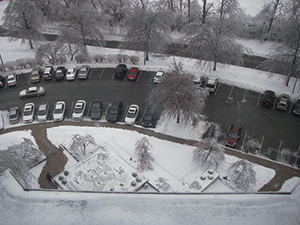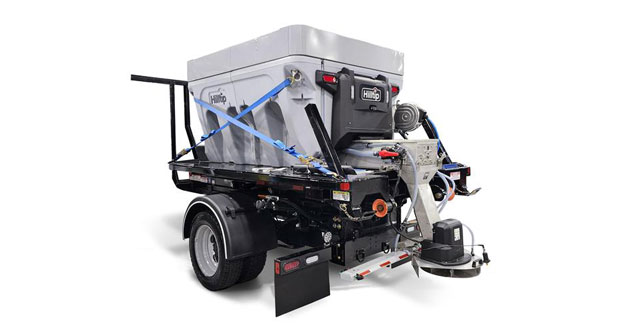The lack of snow in 2011-2012 hit landscapers where it hurts—in their wallets.
2011 will go down as one of the wildest weather years in history. Spring mercilessly flooded landscapes with rain. Summer and fall brought an onslaught of tornadoes. And for much of the country, winter brought, well, nothing — except mild temperatures, that is. So if landscaping companies were seeking redemption in their snow business, they didn’t find it there.
Hard times
This winter was definitely challenging, says Roscoe Klausing, president of Lexington, KY-based Klausing Group, whose snow business constitutes “the highest margin work that we do.”
In 2011, Klausing Group’s snow revenue was down 60 to 75%. “That’s pretty significant,” Klausing laments. “It means you’re going to start the landscaping season cash poor.”
At Environmental Management Services in Dublin, OH, business was a struggle, too. Vice President of Operations Gary Clark says the company usually has enough snow for 8 to 10 plowings and 18 to 30 saltings. But last winter, “some of my customers I didn’t even service,” Clark says.
In fact, only about half of Environmental Management Services’ customers needed plow service, and the company’s snow revenue was down by 80%. “I do about 4 to 5 million (dollars) a year, and this year I did just over a million,” Clark marvels.
“It’s very disheartening when you don’t see any snow falling,” he says. “The double punch for us is we just came off the rainiest year in local Central Ohio history. We’ve seen more rainfall this past year than ever before. My profits were cut in half already because of the amount of rain that fell.”
Since Environmental Management Services relies on its snow revenue to carry it through the spring, the company’s had to turn to banks to get additional lines of credit.
Layoffs
“We do quite a bit of commercial construction,” Clark says, “so it was mild enough here that we did commercial construction and some pruning on trees and shrubs. But I also had to lay off more people than I ever had to before.”
When you lay off employees, there’s always the risk they won’t come back. In fact, 15% of Clark’s employees moved on to other jobs. Since his summer staff usually comprises 350 workers, “15% to me is a lot,” he says. Now, he’s resorted to using temporary services to fill his summer labor positions.
And “that doesn’t work out well,“ he says, “because temporary services, it’s really people who are only mildly interested in finding work. The guys will work for a couple days usually, not more than a week, and then my supervisors are pulling their hair out.”
Hot and cold
Mariani Landscape in Lake Bluff, IL services a 25-mile radius in the Chicago suburbs. Snowfall in 2011-2012 was “very light” says Mariani Service Program Manager Chris Paisley. “We actually had only four plowable events where we sent everybody out.”

Between drivers and shovelers, Mariani Landscape employs 130 snow workers in the winter, servicing about 300 residential properties and 30 commercial properties. The residential clients pay per push, while commercial clients are contracted for the season. Thanks to those commercial contracts, Mariani’s snow revenue was only slightly down in 2011-2012.
“We’re balanced out pretty well,” Paisley says. Having a balance of residential and commercial work is important, he adds, because “in a down year, you still have the contracted work. And in heavier snow years, we may not do as well on the contracted work, because your expenditures on labor, equipment and fuel are greater. In a year like this, it kind of washes itself out.”
Some of Clark’s customers sign contracts for the season as well. Others pay per push. Some of those under contract “were looking at me saying, ‘Do I really have to pay you? There’s no snow,’” he recalls. “Yes, you do.”
As for Mariani, the company was further helped by the fact it didn’t invest in new equipment this winter.
Klausing wasn’t so fortunate.
“We actually ramped up for a pretty significant snow year — invested in several new pieces of equipment,” he says. “We spent about $75,000 building up a salt house that will hold 900 tons of bulk salt. It’s certainly not full, but I’m sitting on a lot of inventory right now.”
In response to the overstock, Klausing Group has made efforts to store salt properly to ensure the company’s inventory does not shrink before the winter of 2012-2013.
Klausing knows full well timing is everything. In the heart of the winter, his service area in Kentucky had just two half-inch snows. “Then of all things, the first week of March we got 5 inches on a Monday morning, which was the first time plows had been run in 13, 14 months,” he says. “It was really challenging.”
Kujawa Enterprises, Inc. (KEI) in Oak Creek, WI, had a slow winter, too. The average snowfall there is 52 inches, says KEI vice president Joe Kujawa. This year, he says, less than 30 inches of snow fell in the area, “and 29 of that came this spring.” His region had a “really weak” November and December, he says. However, KEI’s huge spring business compensated for its winter losses.
 Klausing’s company offers service discounts to customers who purchase retainer fees upfront. He’s sold them successfully for at least 10 years running. After this winter, however, Klausing worries that his clients won’t be so quick to purchase them going forward.
Klausing’s company offers service discounts to customers who purchase retainer fees upfront. He’s sold them successfully for at least 10 years running. After this winter, however, Klausing worries that his clients won’t be so quick to purchase them going forward.
“This is the first time in over a decade that some customers did not utilize their entire retainer fee,” Klausing says. “That could make selling that feature to them more difficult in the future. It’s easy to say, ‘Put some percentage down.’ And when that statement is followed by “We’ve never had anyone not utilize their entire retainer fee,’” it’s a pretty easy sell. Our company wins by getting some cash in the door up front.”
The upside
On the bright side, Clark says, looking at the 2012 season, his sales never have been better. The mild temperatures enabled him to start his landscape maintenance work early this year, and because of a jump in commercial construction, he expects his landscape division to double in size from 2011-2012. His maintenance division, meanwhile, is on track to grow by 15%.
December always has been a busy month for Mariani, producing an average of 23 inches of snow.
“Not this year,” Paisley says.
But that’s not all bad. Like Klausing, Mariani’s snow products, such as salt bags, are still stacked in storage. That means the company will have to buy fewer snow and ice supplies in 2012.
Ultimately, landscapers hope the winter of 2011-2012 doesn’t become the norm. After all, “I haven’t had a winter like this since 1997,” Clark says.
Photos: Roscoe Klausing

